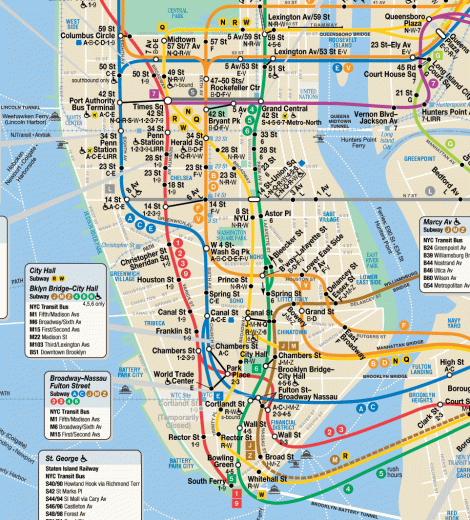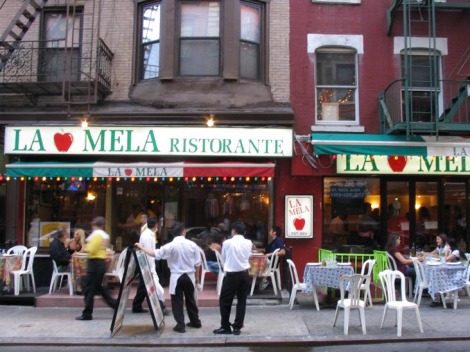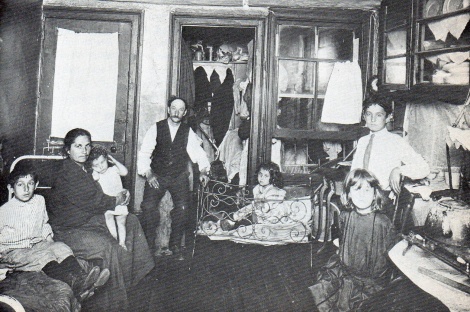Manhattan is full of so many different areas that it is difficult for people to learn about all of them, even if they visit. What are the best attractions to visit or places to eat? This walking tour is designed to give you a vivid image of what a walk down Mulberry Street, which is primarily home to Little Italy, would be like in person.
As can be seen from the map above, Mulberry Street is located between Soho and Chinatown in Lower Manhattan. The part that contains Little Italy is mainly sandwiched between Canal Street and Houston Street. While there are many ways to get to this area, I usually went over in the same way. From our residence in Chelsea, you can take the E or C train to the 4th street station, where you can than transfer to the B train and get off at the station by Broadway and Lafayette.
The official entrance to Mulberry’s Little Italy is where the street intersects with Canal. The best way to get there is to walk down Broadway a bit, taking in the sights and sounds of one of the busiest streets in the world. This part of broadway is filled with shops of all different types, and is bustling with New York residents and tourists alike. Eventually, you will reach Canal Street, where you turn left. You will begin to see the outskirts of Chinatown as you walk up towards Mulberry Street.
If you pay attention here, you will be able to tell that you are close to Little Italy, because the colors and designs of the buildings are still largely the same as they were when Little Italy reached this far west. As immigration from Europe slowed, there were less Italians in the area to sustain the neighborhoods huge size, and many Chinese immigrants began buying out property. The results are obvious today: Chinatown is massive and covers several blocks, while the Italian section is really just confined to Mulberry Street. Most of the businesses in this part of Chinatown were once Italian owned and themed.
Fortunately, preservation efforts have managed to keep Little Italy alive. the countless number of individuals who visit the area and spend their money each year is a massive boon to the city’s economy, not to mention the cultural and historical significance that the neighborhood adds to New York. Manhattan, and America, would not be the same without it. The walk up Canal should be pretty short, before one runs into the very first signs that they are in Little Italy: quaint, red and green painted restaurants pop out at the corner, where guests sit out on little cafe tables enjoying the sunshine, and, of course, a baked ziti or chicken parmesan.
Additionally, the entire street has red, white and green banners hanging above the road, clearly specifying that this is an Italian neighborhood. At night, they light up, and the crowds on Mulberry thin out a bit. It makes for quite a sight, and is a good time to visit if one wants to avoid the crowds and summer heat. Of course, you can also always purchase an authentic Italian Ice from one of the many street vendors to cool off. The food selection here is spectacular, and is hardly limited to the restaurants and cafes that seem to line the entire block. Choosing a place to dine is incredibly difficult, but the good news is that you will be hard pressed to come across a place that doesn’t have delicious food. My favorite was La Mela, which didn’t look the nicest at first glance, but has provided me with many an excellent meal in the past.
When walking down Mulberry Street, it is important to take note of the architecture in the neighborhood. While they may look similar to buildings in many other parts of Manhattan, they were used for a very different purpose: cramming as many immigrant families as possible into as small of a space as possible, so that labor was plentiful and wages could be kept low, helping the businesses and workshops that employed them to grow and prosper. Labor laws, including provisions that deal with child labor, were virtually non-existent during the largest wave of Italian immigration in the late 19th and early 20th centuries. In fact, Little Italy itself and the areas around it, such as NoLita, which stands for North of Little Italy, were once full of dirty, dangerous tenements. Many of them were demolished or converted into more suitable living spaces in later years, so it can be hard to picture what life was like for these new Americans when so little of what they lived in is left. Still, some of it remains, and if you look up at these apartments lining the street, imagine each level occupied with four or five separate families.
As is the case in most parts of New York, visitors can purchase all kinds of trinkets at gift shops and souvenir stands. As you would probably expect, Little Italy has tons of them, and they carry mostly Italian-themed products. In addition to the typical t-shirts, shot glasses, and mini flags, there are also some unique and interesting places that I myself never expected to see in the neighborhood, such as a famous cigar shop about halfway up. No, Italy is not known for its cigars, but you can find pretty much anything here as long as you look hard enough.
Of course, if smoking isn’t your thing, you can always just settle for the standard and inexpensive postcard as a reminder of your visit. Various types of gifts and products, for people of all ages and interests, are available here so long as one appreciates all things Italian.
In all honesty, for the most part, all of Mulberry street sort of looks the same. While this would make most any other place boring and repetitive, it works here, because the whole point of Little Italy today is to immerse one in the culture, sights and sounds of the boot-shaped Mediterranean country that Mulberry is meant to represent. You will notice this while journeying through it. The colors echo those of the Italian Flag, the older Italian gentlemen proudly converse in their native language in the street and on the sidewalk, and the smells of ripe tomatoes and bubbling alfredo fills the air. Of course, tourists from Iowa clog the road and take away slightly from the experience, but that is part of what comes with being a popular destination for visitors. In fact, the neighborhood gets so crowded that most of Mulberry Street is actually blocked off to traffic, meaning that a quick drive-through in your car is usually impossible.
In the past few years, the Italian American Museum was moved from its former home on 44th street to the end of Mulberry Street in Little Italy, where your tour ends. This is a great place for those who are interested in the history, background, plight, and successes of the millions of Italian immigrants who came to America so many years ago. Thanks to the move, Little Italy now provides visitors with an academic incentive to visit as well. I hope that you enjoy this neighborhood as much as I have for the past two months, and make the most out of your visit.










